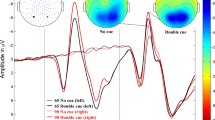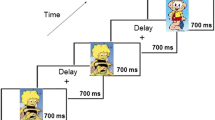Abstract
Event-related potentials (ERPs) evoked by key stimuli informing a subject about the forthcoming recognition of the global or local level of a hierarchical test figure were analyzed in 7-year-old children with different levels of maturity of the regulatory brain systems. Differences in both the initial ERP components P1, N1, and P2 (which reflect the analysis of the sensory characteristics and significance of a key stimulus) and the late components N3, Pc, and Nc (which reflect the preparation for the recognition of a subsequent test figure) were found. It was shown that, in children with frontal-thalamic regulatory system immaturity (FTRSI), the amplitude of the ERP component N1 is decreased in the caudal areas. In children with an immature bottom-up activation system, a decrease in the amplitude of initial ERP components in the caudal areas was observed in a broader time interval in components P1, N1, and P2. As compared to the control groups of children, in children with immature frontal-thalamic structures, components N3, Pc, and Nc were different in both the caudal and precentral areas. In children with immature lower brainstem activation structures, the late ERP components were different, predominantly, in the parietal and temporo-parieto-occipital areas. Comparison of ERPs in response to global and local key stimuli in children of the control group demonstrated a clear-cut temporal and topographical organization in the period of preparation for subsequent recognition of a prescribed level of the test stimulus: the earlier preparation stages were associated with component N3 in the parietal and temporo-parieto-occipital areas, whereas later stages were associated with Pc changes in the frontal areas. In children with FTRSI, changes in the late components in the caudal areas were poorly expressed and their topographical organization (characteristic of the control group) was absent; the involvement of the frontal areas in the late stages of the key stimulus analysis was restricted. These findings may give grounds to suggest the significance of the frontal-thalamic system in the organization of the response to an expected stimulus. In children with immature lower brainstem activation structures, the type of the key stimulus was reflected in the late ERP components in a diffuse way.
Similar content being viewed by others
References
Roland, P.E., Cortical Regulation of Selective Attention in Man. A Regional Cerebral Blood Flow Study, J. Neurophysiol., 1982, vol. 48, no. 5, p. 1059.
Machinskaya, R.I., Machinskii, N.O., and Deryugina, E.M., Functional Organization of the Right and Left Hemispheres of the Human Brain during Selective Attention, Fiziol. Chel., 1992, vol. 18, no. 6, p. 77.
Bastiaansen, M.C., Bocker, K.B., Brunia, C.H., et al., Event-Related Desynchronization during Anticipatory Attention for an Upcoming Stimulus: A Comparative EEG/MEG Study, Clin. Neurophysiol., 2001, vol. 112, no. 2, p. 393.
Brunia, C. H. and van Boxtel, G. J., Wait and See, Int. J. Psychophysiol., 2001, vol. 43, no. 1, p. 59.
Kotchoubey, B., Wascher, E., and Verleger, R., Shifting Attention between Global Features and Small Details: An Event-Related Potential Study, Biol. Psychol., 1997, vol. 46, no. 1, p. 25.
Yamaguchi, S., Yamagata, S., and Kobayashi, S., Cerebral Asymmetry of the “Top Down” Allocation of Attention to Global and Local Features, J. Neurosci., 2000, vol. 20, no. 9, p. RC72.
Beteleva, T.G. and Petrenko, N.E., Mechanisms of Selective Attention in Adults and Children As Reflected by Evoked Potentials to Warning Stimuli, Fiziol. Chel., 2006, vol. 32, no. 5, p. 15 [Hum. Physiol. (Engl. Transl.), 2006, vol, 32, no. 5, p. 509].
Machinskaya, R.I., Neurophysiological Mechanisms of Voluntary Attention (Analytical Review), Zh. Vysvh. Nerv. Deyat. im. I.P. Pavlova, 2003, vol. 53, no. 2, p. 133.
Machinskaya, R.I., Functional Maturation of the Brain and Formation of the Neurophysiological Mechanisms of Selective Voluntary Attention in Young Schoolchildren, Fiziol. Chel., 2006, vol, 32, no. 1, p. 26 [Hum. Physiol. (Engl. Transl.), 2006, vol, 32, no. 1, p. 20].
Farber, D.A., Beteleva, T.G., Gorev, A.S., et al., Functional Organization of the Developing Brain and Formation of Cognitive Activity, Fiziologiya razvitiya rebenka (teoreticheskie i prikladnye aspekty) (Developmental Physiology of a Child (Theoretical and Applied Aspects)), Bezrukikh, M.M. and Farber, D.A., Eds., Moscow: Obrazovanie ot A do Ya, 2000, p. 82.
Farber, D.A., Development of the Visual Perception in Ontogeny. Psychophysiological Analysis, Mir Psikhol., 2003, vol. 2, no. 34, p. 114.
Dubrovinskaya, N.V., Neirofiziologicheskie mekhanizmy vnimaniya (Neurophysiological Mechanisms of Attention), Leningrad: Nauka, 1985.
Machinskaya, R.I., Lukashevich, I.P., and Fishman, M.N., Dynamics of the Brain Electrical Activity in 5-to 8-Year-Old Normal Children and Children with Learning Difficulties, Fiziol. Chel., 1997, vol. 23, no. 5, p. 5 [Hum. Physiol. (Engl. Transl.), 1997, vol. 23, no. 5, p. 517].
Hillyard, S.A., Anllo-Vento, L., Event-Related Brain Potentials in the Study of Visual Selective Attention, Proc. Natl. Acad. Sci. USA, 1998, vol. 95, no. 3, p. 781.
Heinze, H., Luck, S., Mangum, G., and Hillyard, S. Visual Event-Related Potentials Index Focused Attention within Bilateral Stimulus Arrays. I. Evidence for Early Selection, Electroencephalogr. Clin. Neurophysiol., 1990, vol. 75, no. 6, p. 511.
Fu, S., Greenwood, P.M., and Parasuraman, R. Brain Mechanisms of Involuntary Visuospatial Attention: An Event-Related Potential Study, Human Brain Mapp., 2005, vol. 25, no. 4, p. 378.
Taylor, M.J., Non-Spatial Attentional Effects on P1, Clin. Neurophysiol., 2002, vol. 113, no. 12, p. 1903.
Uhlrich, D.J., Tamamaki, N., and Sherman, S.M., Brainstem Control of Response Modes in Neurons of the Cat’s Lateral Geniculate Nucleus, Proc. Natl. Acad. Sci. USA, 1990, vol. 87, no. 7, p. 2560.
Murphy, P.C., Uhlrich, D.J., Tamamaki, N., and Sherman, S.M., Brain-Stem Modulation of the Response Properties of Cells in the Cat’s Perigeniculate Nucleus, Vis. Neurosci., 1994, vol. 11, no. 4, p. 781.
Fjeld, I.T., Ruksenas, O., and Heggelund, P., Brainstem Modulation of Visual Response Properties of Single Cells in the Dorsal Lateral Geniculate Nucleus of Cat, J. Physiol., 2002, vol. 543, pt 2, p. 541.
Ozaki, T. and Kaplan, E., Brainstem Input Modulates Globally the Transmission through the Lateral Geniculate Nucleus, Int. J. Neurosci., 2006, vol. 116, no. 3, p. 247.
Newman, J. and Baars, B. A Neural Attentional Model for Access to Consciousness, Concepts in NeuroScience, 1993, vol. 4, no. 2, p. 255.
Batuev, A.S. Vysshie integrativnye sistemy mozga (Higher Integrative Systems of the Brain), Leningrad: Nauka, 1981.
Luria, A.R., Osnovy neiropsikhologii (The Fundamentals of Neuropsychology), Moscow: Mosk. Gos. Univ., 1973.
Moran, J. and Desimone, R., Selective Attention Gates Visual Processing in the Extrastriate Cortex, Science, 1985, vol. 229, no. 4715, p. 782.
Desimone, R., Visual Attention Mediated by Biased Competition in Extrastriate Visual Cortex, Philos. Trans. R. Soc. Lond. B. Biol. Sci., 1998, vol. 353, no. 1373, p. 1245.
Chelazzi, L., Duncan, J., Miller, E., and Desimone, R., Responses of Neurons in Inferior Temporal Cortex during Memory-Guided Visual Search, J. Neurophysiol., 1998, vol. 80, p. 2918.
Krupskaya, E.V. and Machinskaya, R.I., Organization of Selective Attention in 7-to 8-Year-Old Children with Different Levels of Maturity of the Regulatory Brain Structures, Kul’turno-istorucheskii podkhod I issledovanie protsessov sotsializatsii. Materialy chtenii pamyati L.S. Vygotskogo. 5-ya mezhdunar. konf. Moskva, 15–17 noyabrya 2004 (Cultural-Historical Approach and Investigation of Socialization Processes. Proceedings of L.S. Vygotskii Readings. The 5th Int. Conf. Moscow, November 15–17, 2004), Moscow: RGGU, 2005, p. 269.
Author information
Authors and Affiliations
Additional information
Original Russian Text © T.G. Beteleva, N.E. Petrenko, 2007, published in Fiziologiya Cheloveka, 2007, Vol. 33, No. 3, pp. 15–25.
Rights and permissions
About this article
Cite this article
Beteleva, T.G., Petrenko, N.E. Organization of selective attention during preparation for the recognition of global and local characteristics of a visual stimulus in children with different levels of maturity of the regulatory brain systems. Hum Physiol 33, 267–276 (2007). https://doi.org/10.1134/S0362119707030024
Received:
Issue Date:
DOI: https://doi.org/10.1134/S0362119707030024




